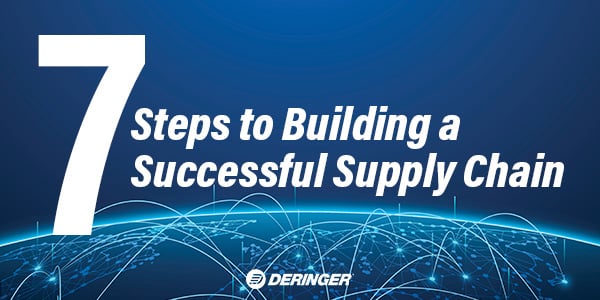
Moving goods across the globe has become a Herculean feat as importers face off against complex challenges driven by a pandemic, labor and equipment shortages, port congestion, and shipping delays. With the uncertainties of today’s international shipping landscape, flexibility is the key to success.
While it’s impossible to prevent some challenges from arising during the shipping process, shippers can avoid negative outcomes by building a successful supply chain that:
- Remembers the end-user
- Plans ahead
- Teams with a reliable logistics partner
- Develops agile sourcing
- Maintains several shipping options
- Audits performance
- Keeps costs in check
There are more than 70 ships currently anchored outside the ports of Long Beach and Los Angeles waiting to unload. Similar backups and equipment shortages persist in other terminals, as well, and goods are getting delayed all over—sometimes for up to a month! Empty shelves in stores across the U.S. make it hard to ignore the current supply chain crisis.
When there are holes in the supply chain, things inevitably fall through the cracks. The one who suffers is the end-user—the person who pays your company’s bills. Shipping delays can damage your company’s reputation and cost you money.
Now’s the time to pay close attention to your supply chain and get ready to switch gears at a moment’s notice. In a volatile, ever-changing supply chain environment, successful shippers depend on agility to make things work.
Here are seven tips to help you build a successful supply chain that functions smoothly—even amid a disruption.
1. Keep Your End-User in Mind
Your end-user doesn’t care what caused delivery delays. They want the product they ordered today to show up tomorrow. When they go to a store, they want to see stocked shelves.
Sourcing from quality suppliers, knowing your transportation costs, and ensuring that you meticulously manage your inventory will lead to a seamless supply chain operation.
Here, visibility reigns as king. You need to know where you’re sourcing your products from and where they are going. Visibility across your entire supply chain—paired with a strong transport partner—can help you pivot midstream and solve problems without delays that impact your customers.
2. Plan Ahead
Transit times are longer than ever, causing carrier reliability to drop under 20% on both the East and West coast. It’s often taking twice as long to move goods from Asia to the U.S., and it’s costing 400% more.
The winner in this game is the shipper, who plans ahead and works with a logistics partner as problems inevitably arise.
This collaboration begins with knowing where products originate, and where they need to go. Shippers need strong supplier partnerships, as well as reliable relationships at the destination. You rely on your suppliers to make and ship your goods while adhering to the rules and regulations for importing them, and you rely on your partners for processing your shipments correctly.
Base your partner selection on their capabilities, as well as how they align with your business strategy. For instance, if you’re shipping chemicals, partner with a specialist who works in that industry. If you’re importing seasonal products, pick a logistics partner with a track record for getting goods delivered on time; seasonal goods that arrive late will cost you money—you might end up selling snowboards or winter jackets that arrive in March at a discount.
It may make sense to order in excess or order early and store goods to avoid risking late deliveries. Many retailers charge a fee for late or missed deliveries—not to mention that late deliveries can also damage your reputation.
3. Find a Reliable Logistics Partner
If your company lacks a dedicated logistics team or in-house supply chain manager, you need a specialist's assistance. A freight forwarder can help you navigate shipping in a disruptive supply chain environment, guiding shippers through the process of moving products from Point A to Point B. They arrange air or ocean freight, truck or rail transport, and act as a broker and intermediary between shippers and carriers.
Through transparency, open communication, and strong supply chain visibility, the right partner can help you navigate the challenges of a volatile shipping market. Just make sure to select a trade partner with experience in your vertical.
If you're looking for more information on what may constitute a quality freight forwarder, you should read this blog, Benefits of Using a Freight Forwarder.
4. Agile Sourcing
An agile approach to sourcing depends largely on planning. Imagine you only have one supplier for your goods—you may struggle to receive those goods on time if something were to disrupt that single supplier’s route. However, if you choose several manufacturers in different geographic locations, you can use multiple trade lanes to move your goods. When one trade lane gets congested, another may be open.
Moving goods inland also presents challenges to shipping. In fact, railyards are currently using a trend called “metering” to limit the number of containers moving inland due to congestion. Sometimes it’s more efficient to source goods closer to seaports, even if doing so costs a bit more because it eliminates inland travel delays.
A trusted source advisor can guide your sourcing decisions to boost supply chain agility. Some partners can even offer advanced technology that shows your shipment in real time along its journey. Overall, a supply chain has many moving parts, so it’s best to rely on the experts.
5. Maintain More than One Shipping Option
As mentioned above, don’t put all your eggs into one basket. Diversify your shipments in case one transportation mode goes down.
Let’s say your goods need to get to Chicago. There are roughly 15 routes you can use to move freight there. You’ll want your freight partner to advise you on all the options, then diversify the load to ensure at least part of your shipment arrives on time. The right partner has relationships with carriers that offer a variety of transport options.
When time is of the essence, ship by air. It costs more, but it’s faster—and when delays occur, airlines can recover in hours or days, whereas sea carriers may take weeks to rebound.
6. Audit Performance
Though auditing performance won’t help your initial runs, it’s a critical step toward building a resilient and reliable supply chain. Put KPIs and SMART goals in place to audit your supply chain since these objectives will ultimately guide your strategic supply chain decisions.
A qualified international freight forwarder or 3PL can help you set KPIs and SMART goals that measure supply chain performance. You can even hire these trusted partners to audit your existing supply chain to uncover waste.
Your partner must understand all supply chain processes to evaluate, compare, and manage supply chain performance. This data can help develop strategies and assign tasks to establish accountability and responsibility among all parties.
Set KPIs and SMART goals from the onset of your relationship with a freight partner. This professional can evaluate transit times and costs to move your products in the most cost-effective and timely way possible.
7. Keep Costs in Check
Unfortunately, even when you make these efforts, you will pay far higher shipping costs than you did a year ago. Shipping prices have skyrocketed up to 400%. As a result, you may need to raise prices for your products to offset the cost. A freight partner will take the necessary steps to save you money and reduce the costs you must pass on to customers.
When problems arise, your logistics partner will help you correct them to ensure similar issues don’t happen again. The goal, always, should be continuous improvement. Constantly refining supply chain operations also keeps costs in check.
The shipping climate may be rocky for months. But by remembering the end-user, planning ahead, staying agile, and monitoring performance, your supply chain can thrive even as obstacles get in the way.



